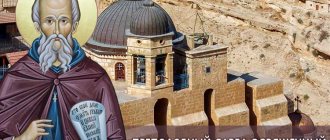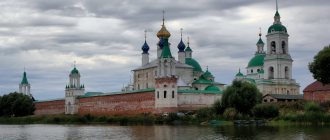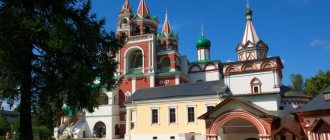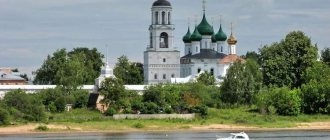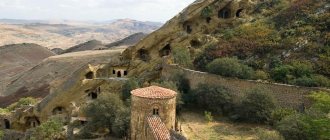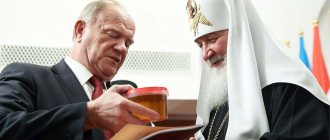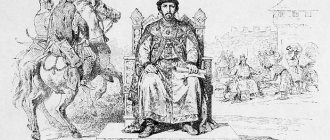There are many saints in Christianity, each with their own special story, but the life of Saint Sava the Sanctified was truly amazing. Savva devoted all the years allotted to him to serving the Lord, fulfilling His will on earth. Therefore, many Christians read prayers to this saint and ask him for help for healing and the gift of children.
Biography of Sava the Sanctified
Memorial Day: December 18
The monk was born in the 5th century AD in Cappadocia, into the family of a military commander. The boy's parents, John and Sophia, were righteous Christians. At the age of five, Savva was given to be raised by his uncle, and his father and mother left for Alexandria on duty. At the age of 8, little Savva was accepted into the nearby monastery of St. Flavian, where he immediately showed himself to be a diligent student - he quickly mastered reading and writing and studied the Holy Scriptures.
The next stage of Savva’s life came when he turned 17 years old. The persuasion of his parents to return and marry was unsuccessful, the young man went to Jerusalem to the monastery of St. Euthymius the Great. The monk sent Savva to Abba Theoktistus, to a monastery with strict rules of community life. There he remained until he was 30 years old.
Savva left the monastery after the death of Theoktistus, whose successor blessed the monk for seclusion in a cave. For 5 years, he only left his cave on Saturdays to visit the monastery, where he took part in divine services and ate food. Savva spent the rest of his time serving the Lord and praying. All this time he was watched by the Monk Euthymius, who called Savva a youth-elder.
The death of Euphemia made Savva a recluse - he left the Lavra and finally settled in a cave. A few years later, people began to come to the monk who wanted to become his disciples. They settled in cells in the cave. When the number of students reached 70, a spring opened next to the cave; when the number reached 150, the Great Lavra arose.
People turn to Saint Sava with prayers not only because of his righteous lifestyle, but also for the miracles that he performed. In addition to discovering the source, he is credited with the power of healing from diseases of the body and spirit. During a severe drought, through the prayers of Savva the Sanctified, heavy rain began to fall.
The monk founded more than one monastery and even wrote the first charter of church services, which was taken as a basis by all the monasteries of Palestine. Savva the Sanctified passed away at a respectable age; he was more than 90 years old when in 532 he departed from the world. Until the end of his days, he received those who asked and needed.
Hilandar and SPC
Hilandar is a Serbian monastery that ranks with such Serbian shrines as Vysoki Dečani in Kosovo and Ostrog in Montenegro, but Hilandar is located on Mount Athos, and it was founded by Sava and Simeon. Hilandar became the first and remained the only Serbian Orthodox monastery on the Holy Mountain.
However, then he was simply “Serbian,” and he became “Serbian Orthodox” when Sava achieved autocephaly for the Serbian Orthodox Church from the Byzantine king Theodore I Laskaris and the Patriarch of Constantinople Manuel I Charitopulus Sarantino. At the same time, the monastery remained subordinate to the Patriarchate of Constantinople. But this is not the main thing, the main thing is the new, independent Serbian Orthodox Church.
In 1234, Saint Sava undertook a second pilgrimage to Jerusalem. On my way back I passed through Bulgaria. There he died on January 14, 1236 and was buried in the Bulgarian capital of Tarnovo. Nephew of St. Savva, the Serbian king Vladislav (son-in-law of the Bulgarian king Ivan II Asen), a year later transferred his relics from Tarnov to the Milesheva monastery. Three hundred years after the death of the saint, the Turks, who enslaved the country, burned the relics of Saint Sava in order to humiliate the people and their shrines. Now one of the largest Orthodox churches has been built on this site.
This happened after the fall of Constantinople in 1204, when Manuel I ordained Savva as “archbishop of the Serbian and coastal lands.”
Returning to Serbia, Savva began to found monasteries and laurels and write legislative texts. His Life of Simeon is now considered an example of Serbian medieval literature. Being the abbot of the most important monastery of Studenica in Serbia at that time, Savva also participated in the diplomatic missions of rulers from his family, namely brother Stefan Nemanjic.
How do Sava’s prayers to the Sanctified help?
It is customary to read a prayer to St. Savva to childless couples who have been unable to have a child for a long time. It is better to do this in the temple; it would not be amiss to ask for a blessing in the church. The saint's memorial day is December 18, on this day you should attend a service.
The prayer to Sava the Sanctified for the gift of children must be said sincerely; future parents must believe in their request and not be disingenuous. New life is God’s gift and a great responsibility, so people turn to prayer only in extreme cases, when only faith remains.
In the life of the saint, there are many cases when he delivered the sick from ailments and cured the possessed. The miraculous deeds did not go unnoticed, so parishioners read a prayer to Savva the Sanctified for healing from illness.
Reading a prayer to a saint will strengthen a Christian’s faith and bring peace of mind, which heals wounds just as well as medicine.
Heritage
His Great Lavra remained for a long time the most influential monastery in those parts and produced several outstanding monks, among them St. John of Damascus. It is now known as Mar Saba Monastery. The Church of San Saba in Rome is dedicated to him.
In the San Saba River in Texas, other features in the area are named after Savva; it was so named because Juan Antonio Bustillo y Ceballos discovered the river on the day of Saint Sava, December 5, 1732, and named it Rio de San Saba de las Nueces
(“River of St. Sava Walnuts”).[3]
Prayer to St. Savva the Sanctified
Oh, wonderful and all-praised servant of God, reverend Father Savvo! Today (in your holy temple), standing reverently before your holy icon and joyfully commemorating your blessed memory, we bless you, our intercessor. Honoring your great boldness before the Lord, we humbly pray to you, most blessed one, to graciously accept from us this song of praise, brought to you out of love and zeal. And, since you have great boldness in the Lord, you strive through your pleasing intercession to ask the King of kings and the Lord of lords, so that He may add His great and rich mercies. upon us sinners, may He give us the spirit of right faith, the spirit of knowledge and love, the spirit of peace and joy about Holy Spirit, may He deliver us from troubles and misfortunes, and may He send down everything useful for the salvation of our souls. May all the Orthodox send down peace, silence, serenity, zeal for fulfilling His commandments, an abundance of earthly fruits; May he deliver the entire Russian country from famine, cowardice, flood, fire, sword, invasion of foreigners and internecine warfare, deadly plagues and from all evil. Hey, saint of God! Do not despise our prayers, but hear us praying to you, and under the roof of your intercession, keep us (and this monastery) hated from enemies, visible and invisible, so that we may be deemed worthy to end our life in repentance we will receive eternal goodness in the kingdom of Christ our God, where we will praise with by you and all the saints, the venerable name of the Most Holy Trinity, the Father, and the Son, and the Holy Spirit, forever and ever. Amen.
( 3 ratings, average: 4.33 out of 5)
Quotes from the Holy Fathers for every day
On January 25, the Russian Orthodox Church honors the memory of St. Sava, the first Archbishop of Serbia. Saint Sava can safely be called the father of the Serbian nation; his veneration in his homeland, and throughout the Balkans, as well as on Holy Mount Athos, is widely known. However, the saint is not a stranger to Russia either.viagra gegenanzeigenviagra kaufen
argaiv1076
At first, the name of the Serbian archbishop became known in Rus' as the name of the author of the Law Rules - a set of canonical and civil law, which remained the basis of church normative regulation in Russia until 1917.
The fact is that it was under the leadership of Saint Sava that this Roman-Byzantine code (Nomocanon) was translated into the Slavic language, supplemented and adapted.
The oldest surviving Russian list of the Svetosavskaya Helmsman (or simply the “Helmsman’s Book”) is the Ryazan one, dated 1284, that is, created during the lifetime of the saint’s spiritual children. A large printed publication of the Helmsman's Book took place in Russia shortly before Nikon's reforms, in 1650, with the blessing of Patriarch Joseph.
What is the reason for such vitality of the Svetosavskaya Helmsman in Rus'?
The fact is that this purely legal and, it would seem, exclusively applied document reflected the entire spiritual and legal heritage of Byzantium. It was in this book that the idea of a symphony of ecclesiastical and secular power was clearly formulated. And the first example among the Slavic peoples of the embodiment of the evangelical meaning of power in state governance was the Serbian kingdom, headed by two holy brothers: Archbishop Sava and King Stephen.
The veneration of Sava as a saint began in Rus' somewhat later, with the restoration of Russian-South Slavic ties at the end of the 14th century through the monasteries of Athos and Constantinople. Rus', during the reign of Grand Duke Dmitry Donskoy and his son Vasily, gradually freed itself from the Horde yoke, strengthened and grew rich, while the Byzantine world was increasingly oppressed by the Turks and Latins. Our southern co-religionists needed material and diplomatic support from Moscow. Rus' needed learned men, theologians, icon painters, translators, gunsmiths, architects, and engineers. Both Byzantium and Serbia could and did give all this.
After the Kosovo disaster of 1389, the flow of Serbs to Rus' increased even more. In the 15th century, the hagiographer Pachomius the Serb worked in the Trinity-Sergius Monastery, and the Serb Lazar installed the first chimes in the Moscow Kremlin. Along with the Serbian monks and their books, the veneration of Saint Sava also came to Rus'.
However, until the middle of the 15th century, it is more appropriate to talk only about the acquaintance of the educated part of Russian society (primarily monasticism) with the veneration of this saint in his homeland and on Mount Athos. The memory of St. Sava begins to appear in the monthly books (for example, in the Gospel of St. Kirill of Belozersky); in the service books his name is mentioned together with the name of his father, Venerable Simeon the Myrrh-Streaming, at the liturgy; the troparion and kontakion appear in the troparions; as part of the new edition of the Prologue there is a short life.
In the middle of the 15th century, to justify the legality of the autocephaly of the Russian Church, Moscow ideologists turned to the Bulgarian and Serbian experience of past centuries. Then an unknown author wrote “The Legend of the Bulgarian and Serbian Patriarchates.” A significant part of this text was the life of Saint Sava. From this time on, we can talk about a pronounced interest of Russians in the personality of the first Serbian archbishop.
At the beginning of the 16th century, the life of St. Sava was used as an argument in a dispute between the followers of the venerable Joseph of Volotsk and Nil of Sora (the so-called “Josephites” and “non-possessors,” as they would be called later). The former defended the right of monasteries to own property not only for the maintenance of the brethren themselves, but also for carrying out charitable activities, while the latter argued that monks should completely renounce everything earthly.
The disciple of St. Joseph, Metropolitan Daniel, in a polemic with the “non-covetous” Vassian (Patrikeev), appealed to the fact that St. Savvas of Serbia maintained his monasteries in abundance so that they could realize their social mission. Moreover, in 1517, the monk Isaiah brought to Moscow from Athos a lengthy life of St. Sava, written at the turn of the 13th-14th centuries by Hieromonk Theodosius, and all the details of the life of this great son of the Serbian people became the property of Russian scribes.
By the end of the 16th century, Muscovite Rus' fully realized itself as the heir of the entire Orthodox world. And this role was early recognized by other Orthodox Slavs. Embassies of Athonite monasteries and descendants of Serbian despots from the Brankovic dynasty who lived in Hungary constantly came to the “Third Rome” for alms. Thus, a deeper acquaintance with the cult of St. Sava continued along two lines at once.
The heyday of the cult of Sava the Serbian in Rus' occurred during the reign of Tsar Ivan IV the Terrible. This was facilitated by a combination of many factors: the development of ideologies embedded in the reign of his father Vasily III, and the veneration of Saints Sava and Simeon as the creators of the Serbian state and church, associated with Ivan’s acceptance of the royal title in 1547, and patronage of the monasteries of Athos, and dynastic roots: Ivan the Terrible's grandfather Ivan III was married to Sophia Paleologus, whose father Thomas was the son of the Byzantine Emperor Manuel II and Elena Dejanovic-Dragash, daughter of the Serbian nobleman Konstantin Dragash. Konstantin Dragaš in turn was the son of the despot Dejan and Theodora Nemanjić, daughter of King Stefan Dečanski and therefore a descendant of Nemanja himself. Consequently, the blood of the holy tree of the Nemanjić flowed in Ivan the Terrible’s paternal grandmother.
On the other hand, Ivan's mother Elena Glinskaya was the daughter of Vasiliy and Anna Jaksic, the granddaughter of the voivode despot Djuradz Branković, and the daughter of the voivode Stefan Jaksic. Her sister Jelena married the despot Jovan Branković, the great-grandson of the holy prince Lazar and his wife Milica. Thus, both on his father’s side and on his mother’s side, Ivan Vasilyevich had Serbian roots.
Baba Anna also directly participated in the upbringing of the king. The Serbian writer Milovan Vitezovich writes about her role: “His education was undertaken by the one who taught his mother, instilling in her pride, self-esteem and determination. She now instilled the same thing in her grandson... She introduced him to the Serbian spiritual and state-forming teachings of Saint Sava. She told him about the heyday of the holy Nemanjić dynasty - from Stephen, the collector of Serbian lands, to Dusan the Strong, his glorious crowning of the kingdom, his councils and the publication of the Law Book. He also learned about the death of the Serbian kingdom and the fate of Prince Lazar. Ivan’s reference book was the life of Saint Sava, written by Theodosius, brought and presented to his father by the Athonite monk Isaiah. He recalled his impressions with admiration at the end of his life: “And how Saint Sava left his father, mother, brothers, relatives and friends along with the whole kingdom, the nobility and took on the cross of Christ, and what monastic feats he performed! And how his father Nemanja, that is, Simeon, and his mother left the kingdom and replaced the purple robe with a monastic robe, and how after that they found consolation and joy!
Already at the beginning of their reign, in 1549, Savva and Simeon of Serbia were officially canonized by the Russian Church, included in the number of “new miracle workers” along with Russian saints. From this time on, their images on Russian icons became common. A pair of their images in prayer is placed on the pillar of the Kremlin Archangel Cathedral, which serves as the tomb of Russian princes and tsars.
In total, along with the Russian sovereigns, four “foreigners” are represented in the paintings of the Archangel Cathedral. Of these, three are Serbs: Saints Simeon, Sava and the Kosovo passion-bearer Lazar. With this, Ivan IV once again demonstrated his origins.
It is curious that the only saint depicted in the temple twice was Saint Sava (once with his father, the Monk Simeon; the second - alone).
Already at the end of the reign of the “formidable tsar”, Russian artists created illustrations for the life of the saint to the extent that it was included in the Litsey Chronicle. Several dozen miniatures exceed in volume everything that existed on this topic in medieval Serbian art.
For some time, until the frescoes of Georgiy Mitrofanovich from the refectory of the Hilandar Monastery became available to Russian researchers, it was even assumed that both cycles go back to the same prototype - the unpreserved illustrated life of the first Serbian archbishop. However, the difference in the composition of miniatures and murals, as well as the complete absence of Balkan realities in the works of Russian masters, indicate that the latter were completely independent.
In 1550, Hilandar abbot Paisiy and three brothers arrived in Moscow. In a letter addressed to Tsar Ivan Vasilyevich, the Hilandars called him “the king of all Orthodox Christians,” “the Christian sun” and “the second Constantine.” They complained about the poverty in which they lived since the Serbian rulers died, that the sacred vessels had to be pawned to the Turks and Jews, and also that the Greeks took away their possessions. They asked Ivan to intercede for them before Sultan Suleiman, they described the difficult situation in which the Russian monastery of St. Panteleimon was also, emphasizing that “our monasteries of the Slavic language in Greek land are in a foreign land.”
The king immediately sent a letter to Sultan Suleiman, asking him to protect both monasteries from oppression. In 1556, the Hilandar monks again came to Ivan’s court. The Emperor presented them with valuable gifts: money, books, vessels and other utensils, as well as a catapetasma, which was embroidered by his wife Anastasia and on which, along with Russian saints, Saints Savva and Simeon were depicted. Two years later, Archimandrite Prokhor came to Moscow, who, on behalf of the Hilandar brethren, presented the Tsar with a panagia with a piece of the Honorable Cross of the Lord, and the Tsarina with an icon of the Mother of God Quick to Hear, which belonged to the Serbian Patriarch, Saint Spyridon.
Ivan the Terrible also helped the Milesheva monastery, in which the relics of St. Sava rested. Ivan Vasilyevich presented the monastery with a cover for the shrine of the saint, as well as a cup, which is still kept in the museum of the Serbian Orthodox Church in Belgrade.
As of the beginning of 2022, there is not a single operating church in Russia dedicated to St. Sava of Serbia. However, such a church was founded in Yekaterinburg and has the status of a bishop's metochion, the community has existed since 2003, services are now held in a wooden church dedicated to the saint's father, the Monk Simeon the Myrrh-Streaming.
Igor Ryzhov
Veneration and glorification of St. Savva of Storozhevsky
Local veneration of the Monk Savva of Zvenigorod began immediately after his repose. The first icon of the saint was painted at the beginning of the 16th century by the abbot of the Savvino-Storozhevsky Monastery, Dionysius. In a charter of 1539, the Monk Savva is called a miracle worker. In the middle of the 16th century. a description of the miracles was compiled. The church-wide glorification of the saint took place in 1547, on the initiative of the monastery brethren and Metropolitan Macarius of Moscow, and on January 19 (29), 1652, after 245 years of sojourn in damp soil, the incorruptible relics of the saint were found. The oak tomb with the relics was placed in the Nativity of the Virgin Cathedral at the southern gate of the altar.
external reference
| Wikisource has original works written by or about: Sabva |
- Saint Sava the Consecrated Greek Orthodox Archdiocese of Australia
- Saint Sava the Consecrated Orthodox icon and synaxarium (December 5)
- Index of Patron Saints: Saint Sava
- Portal of Saints
| Authoritative control |
|
Troparion, kontakion and canon to St. Savva of Storozhevsky
Troparion, tone 8:
You appeared in the desert to provide good vegetation, reverend, from your youth you willed a pure life. Having followed the spiritual teacher, he fixed his mind on the heavenly teachings, and the teacher showed himself to his flock to be wise. In this way Christ also brightened thee lamp with miracles. Savo, from our souls, pray for our souls to be saved.
Kontakion, voice 2:
Inflamed by the Lord's desire, the passions of the flesh were shaken off by abstinence, and the divine light, the unstoppable luminary, appeared. You illuminate miracles with the rays of all that flow to the race of your relics, O Reverend Father Savo.
Library of the Russian Faith Canon to St. Sava of Storozhevsky →
Read online
Old age
Despite the large number of disciples, Saint Sava did not change his previous customs of occasionally being alone. Like his mentor Euthymius, Savva retired to the deserted desert during Lent. Once, while in solitude, he settled on Mount Castelli. Having cleansed the place from demons with prayers, he founded a monastery for monks whose life had been tested by the harsh desert.
Icon of Saint Sava
In 512, St. Savva the Sanctified with a group of monks were sent to Emperor Anastasius, who ruled in Constantinople. Their goal was to support Orthodoxy and benefits for the Jerusalem churches. Upon arrival at the palace, the guards considered the monks to be poor wanderers, and did not want to let them inside, but were allowed in by the Will of God. Savva pleasantly impressed the emperor, so much so that Anastasius often invited him to his place, pleased by the wisdom of the Saint.
The end of the earthly journey
During the brutal uprising of the Samaritans, which occurred in 531, the Monk Sava the Sanctified turned to Emperor Justinian in Constantinople with a request for help. Savva, possessing a prophetic gift, did not remain in debt and told the emperor about the future conquest of Africa and Rome, about victories over Origenism, monofestism and nestorism. All this should glorify Justinian. And the emperor helped.
Returning back to Jerusalem, Savva became the founder of the Jeremiah Monastery, after which he forever went to the Great Lavra, where he rested until he was 94 years old and died of illness on December 5, 532. He named Saint Melito as his successor.
Savvino-Storozhevsky Monastery
The currently operating Savvino-Storozhevsky Monastery (ROC) is located on Mount Storozhi at the confluence of the Storozhka River with the Moscow River, 2 km west of the city of Zvenigorod, Moscow Region.
In honor of the Venerable Savva of Storozhevsky, the chapel of the Cathedral of the Nativity of the Blessed Virgin Mary of the Savvino-Storozhevsky Monastery, built at the beginning of the 15th century, was consecrated.
Cathedral of the Nativity of the Blessed Virgin Mary of the Savvino-Storozhevsky Monastery with a chapel in honor of St. Savva Storozhevsky
In the 15th-17th centuries, the monastery played an important strategic role in the defense of the western side of the capital, and also became a favorite place of prayer for many Russian tsars. Ivan IV the Terrible with his wife Anastasia Romanovna and their son Fyodor Ioannovich visited here. Under Tsar Alexei Mikhailovich, the monastery turned into a country royal residence. At this time, the empress's palace, royal chambers and external stone walls were erected in the monastery. The temples of the monastery were painted by the most famous icon painters of the Armory Chamber of the Moscow Kremlin.
The Zvenigorodsky tract was laid from Moscow to the Savvino-Storozhevsky Monastery, which was also known as the Tsar’s Road or the Road of God’s Chosen Kings; all Russian rulers: grand dukes, tsars and emperors made obligatory pilgrimages to the monastery to the relics of Savva Storozhevsky more than once. In the first half of the 20th century, this road was called Zvenigorodskoe Highway, but now it is better known as Rublevo-Uspenskoe Highway.
Savvino-Storozhevsky Monastery
Soon after the revolution, the monastery was closed and destroyed. On March 17, 1919, the relics of St. Savva were uncovered. The result of the opening of the relics was published in the report of the VIII department of the People's Commissariat of Justice of the RSFSR to the Congress of Soviets, in which it was described as follows: “a doll made of cotton wool; there are 33 badly destroyed and broken bones in the wool.” On April 5, 1919, the relics of St. Savva were removed from the monastery, and the monastery itself was finally closed. Until the early 1930s, the relics of St. Savva were kept in Lubyanka, then they were transferred to Zvenigorod resident Mikhail Uspensky, who bequeathed their return to the Church. In 1985, his heirs transferred the relics to the Moscow Danilov Monastery; in August 1998, they were solemnly transferred to their native monastery - to the Nativity Cathedral of the Savvino-Storozhevsky Monastery, where they are currently kept.
Cancer with the relics of St. Savva Storozhevsky
Nowadays, the monastery ranks third in Russia in terms of pilgrim attendance, after the Trinity-Sergius Lavra and the Seraphim-Diveyevo Monastery.
On the icon of the Monk Savva, he is depicted as an old man with a scroll
The icon of Sava the Sanctified depicts the saint in old age, with gray hair. Usually they draw an old man with a bald spot - either complete or just beginning
The monk's robe must include a cape. Its color can be green, red, blue, etc. The robe either looks like a monk's, or looks like rags.
In his hand the saint holds a scroll with instructions, prayer, quotation from the Gospel, etc. Sometimes the scroll is twisted.
In icons, Savva the Sanctified usually holds a scroll with spiritual instructions. On this icon, the icon painter decided not to reveal them
